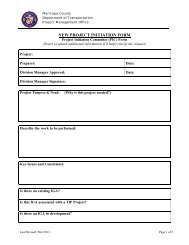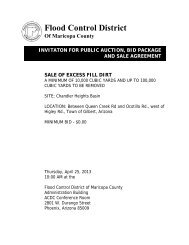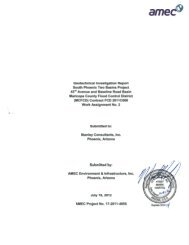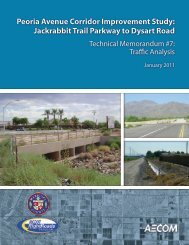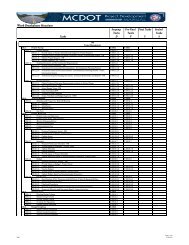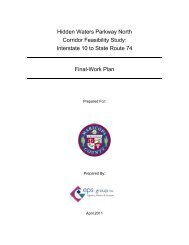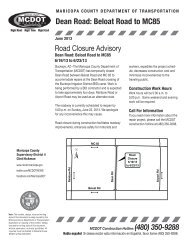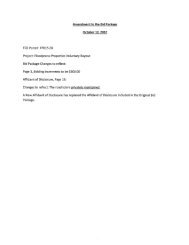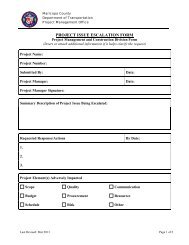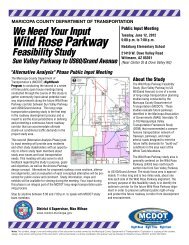Drainage Overview - Maricopa County Department of Transportation
Drainage Overview - Maricopa County Department of Transportation
Drainage Overview - Maricopa County Department of Transportation
You also want an ePaper? Increase the reach of your titles
YUMPU automatically turns print PDFs into web optimized ePapers that Google loves.
3. WATERSHED FEATURES<br />
3.1 Topography and Geology<br />
The study area slopes north and south to large alluvial washes that generally convey flow to the<br />
southeast. The White Tank Mountains are located south <strong>of</strong> the study area. A land form slope<br />
analysis map is provided in Figure 3. The map shows the land slopes mildly north <strong>of</strong> these<br />
mountains.<br />
The Surficial Geology around the White Tank Mountains, Central Arizona (AZGS, 1991) maps<br />
and report delineate the distribution and age <strong>of</strong> alluvial deposits within the study area. According<br />
to the surficial geology maps, most <strong>of</strong> the study area south <strong>of</strong> Wash 1 contains younger deposits,<br />
which may indicate areas <strong>of</strong> occasional to frequent flooding. The remainder <strong>of</strong> the study area is<br />
typically defined as areas where only entrenched channels are subject to flooding, although other<br />
areas <strong>of</strong> low relief could become susceptible to flooding with relatively minor shifts in<br />
depositional patterns. The AZGS maps pertaining to the study area have been included as<br />
Appendix TM3-03.<br />
3.1.1 Land Subsidence and Earth Fissures<br />
ADWR has mapped an active land subsidence feature in the West Valley area based on<br />
measurements obtained between 2004 and 2010. The map entitled Land Subsidence in<br />
Western Metropolitan Phoenix (ADWR, 2010) indicates that there has been up to 2 cm (0.8<br />
inches) <strong>of</strong> subsidence within the study area east <strong>of</strong> 195 th Avenue. South <strong>of</strong> the study area,<br />
up to 6 cm (2.4 inches) <strong>of</strong> subsidence has been documented. The extent <strong>of</strong> the land<br />
subsidence is included in Appendix TM3-04. Land subsidence in Arizona typically occurs<br />
due to groundwater drawdown. While subsidence is not considered to be a significant issue<br />
within the study area at this time, as water demand changes with future development, the<br />
increased potential for land subsidence should be considered when building infrastructure.<br />
Based on a review <strong>of</strong> the Earth Fissure Map <strong>of</strong> <strong>Maricopa</strong> <strong>County</strong>, Arizona (AZGS, 2009),<br />
there are no earth fissures mapped within the study area. No surface evidence <strong>of</strong> fissures has<br />
been found, but this conclusion does not guarantee that hidden or future earth fissures are<br />
not present. According to the Wittmann ADMP McMicken Dam Project Alternatives<br />
Analysis (FCDMC, 2008), the northern end <strong>of</strong> McMicken dam, including the spillway, is in<br />
an area <strong>of</strong> low to moderate fissure risk. See Section 3.5.4 for further details.<br />
3.2 Soils<br />
The National Resources Conservation Service (NRCS) assigns soil map unit components to<br />
hydrologic soil groups to broadly indicate soils groups that have similar run<strong>of</strong>f characteristics.<br />
The locations <strong>of</strong> these hydrologic soil groups within the study area are shown in Figure 4. Most<br />
<strong>of</strong> the study area falls within Hydrologic Soil Group B: soils that have moderately low run<strong>of</strong>f<br />
potential when thoroughly wet. These areas typically have a large proportion <strong>of</strong> sands and allow<br />
unimpeded transmission <strong>of</strong> water through the soil. As shown in Figure 4, there are limited<br />
regions that fall within Hydrologic Soil Group C: soils with moderately high run<strong>of</strong>f potential.<br />
Soils in Group C typically have between 20 to 40 percent clay and less than 50 percent sands.<br />
Water movement through these soils is expected to be somewhat restricted.<br />
091337137, 2011-018, TT005 <strong>Maricopa</strong> <strong>County</strong> <strong>Department</strong> <strong>of</strong> <strong>Transportation</strong><br />
Technical Memorandum 3 Deer Valley Parkway Feasibility Study<br />
<strong>Drainage</strong> <strong>Overview</strong> 8 April 2012





